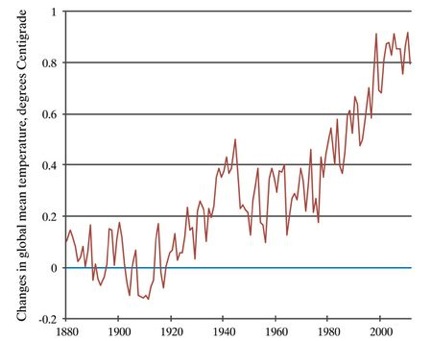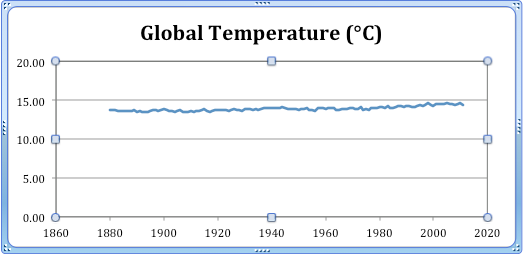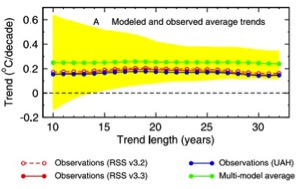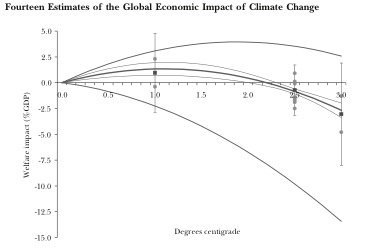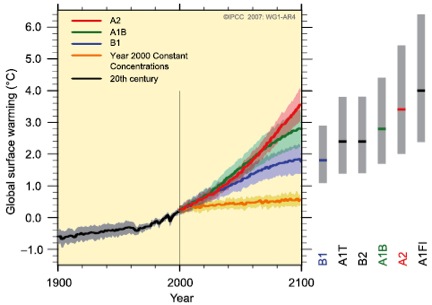William Nordhaus is a professor at Yale University and one of the pioneers in the economics of climate change. Earlier this year Nordhaus wrote a piece in the New York Review of Books entitled, “Why the Global Warming Skeptics Are Wrong.” Because of Nordhaus’ stature in the profession, and because of his supposedly definitive claims, the article was an instant hit in certain circles, even being assigned by economics professors as an excellent introduction to the case for policy activism to fight climate change. Yet as I’ll demonstrate in this post, Nordhaus’ position isn’t nearly as airtight as he leads the reader to believe. There really are good reasons for being skeptical of massive government intervention to fight climate change.
Nordhaus Takes on Sixteen Opponents
To frame his debate with the global warming skeptics, Nordhaus picks a specific target: the January 26 Wall Street Journal op ed titled, “No Need to Panic About Global Warming.” The op-ed was signed by sixteen scientists from various fields, including Princeton physics professor William Happer, MIT professor of atmospheric sciences Richard Lindzen, former head of climate research at the Australian Bureau of Meteorology William Kininmonth, and former director of the Royal Dutch Meteorological Service Henk Tennekes.
Nordhaus identified six allegedly misleading claims made by the skeptics in their WSJ article, and proceeded (in his mind) to dismantle their bogus views. In the interest of brevity, I will in this post focus on just four of the claims. As we’ll see, it is Nordhaus who is playing fast and loose with the readers. Many of the objections raised by the skeptics are indeed legitimate.
Skeptic Claim #1: Global Temperatures Have Been Flat for a Decade
Nordhaus first tackles the claims about the temperature record. He writes:
The first claim is that the planet is not warming. More precisely, “Perhaps the most inconvenient fact is the lack of global warming for well over 10 years now.”
It is easy to get lost in the tiniest details here. Most people will benefit from stepping back and looking at the record of actual temperature measurements. The figure below shows data from 1880 to 2011 on global mean temperature averaged from three different sources. We do not need any complicated statistical analysis to see that temperatures are rising, and furthermore that they are higher in the last decade than they were in earlier decades.
[FIGURE REPRODUCED FROM NORDHAUS.]
Notice the rhetorical sleight-of-hand: Nordhaus attributes the claim that “the planet is not warming” to his critics, and then at least has the courtesy to follow-up with their actual statement that “the most inconvenient fact is the lack of global warming for well over 10 years now.”
Those are different statements. Yes, it’s easy to knock down opponents when Nordhaus is allowed to change their position. The 16 signatories to the WSJ piece never claimed that “the planet is not warming,” relative to preindustrial times. No, what the 16 signatories to the WSJ piece claimed—and which is true, at least depending on which data set one uses—is that there has been no global warming in well over the last ten years. Indeed, look at Nordhaus’ own graph: It shows that the current temperature deviation (of about 0.8 degrees Celsius) is the same value as it was back in the late 1990s. And yet Nordhaus somehow thinks this chart should embarrass his opponents.
It’s also interesting that Nordhaus invites his readers to not get caught up in the tiny details, and instead to take a step back and survey the grand picture of global temperatures. I agree. In that spirit, I suggest it can be misleading to focus—as Nordhaus does—on deviations of temperatures. Instead, let’s look at a graph of actual global temperatures, using the same three standard data sets that Nordhaus used for his own graph. (All we’re doing here is adding a base of 14 degrees Celsius to the deviations that Nordhaus plots.) The graph looks like this:
SOURCE: Data sets cited by Nordhaus, with 14C base global temperature added to deviations.
Seen in this light, it’s still true that temperatures of the last decade are higher than at any point since the late 19th century, yet this chart isn’t nearly as scary as the one Nordhaus showed.
To be clear, I’m not accusing Nordhaus of anything deceptive regarding the format of his temperature chart. There are good reasons that climate scientists tend to work with temperature deviations, rather than absolute levels.[1] Furthermore, without more information to guide our charting decisions, choosing a y-axis range of 0–20 Celsius degrees—as I’ve done in the graph above—is just as arbitrary as Nordhaus implicitly choosing a range of 14–15 degrees in the graph he used. Even so, when experts such as Nordhaus are presenting their material to the layperson, these nuances can get lost in the shuffle. Nordhaus thought his readers would “benefit from stepping back and looking at the record of actual temperature measurements,” and I agree.
Skeptic Claim #2: Actual Global Warming Has Been Smaller Than What the Models Predicted
Next Nordhaus tackles the argument that the computer simulations have thus far greatly exaggerated the impact of CO2 emissions on global temperatures. Nordhaus defends the track record of the models in this way:
What is the evidence on the performance of climate models? Do they predict the historical trend accurately? Statisticians routinely address this kind of question. The standard approach is to perform an experiment in which (case 1) modelers put the changes in CO2 concentrations and other climate influences in a climate model and estimate the resulting temperature path, and then (case 2) modelers calculate what would happen in the counterfactual situation where the only changes were due to natural sources, for example, the sun and volcanoes, with no human-induced changes. They then compare the actual temperature increases of the model predictions for all sources (case 1) with the predictions for natural sources alone (case 2).
This experiment has been performed many times using climate models. A good example is the analysis described in the Fourth Assessment Report of the Intergovernmental Panel on Climate…. Several modelers ran both cases 1 and 2 described above—one including human-induced changes and one with only natural sources. This experiment showed that the projections of climate models are consistent with recorded temperature trends over recent decades only if human impacts are included. The divergent trend is especially pronounced after 1980. By 2005, calculations using natural sources alone underpredict the actual temperature increases by about 0.7 degrees Centigrade, while the calculations including human sources track the actual temperature trend very closely.
In reviewing the results, the IPCC report concluded: “No climate model using natural forcings [i.e., natural warming factors] alone has reproduced the observed global warming trend in the second half of the twentieth century.”
The above quotation from Nordhaus is lengthy, but I wanted the reader to trust that I was capturing the context. Notice what Nordhaus has done: When faced with a skeptic challenge that the climate models predict more warming than has actually occurred, Nordhaus retreated to defending the view that the prevailing suite of climate models explains past temperature movements better when they attribute a sizable impact to human activities, than if these computer models are run with natural influences (“forcings”) alone.
These are entirely different claims. The WSJ scientists were not claiming that anthropogenic changes to the atmospheric composition have not given rise to an increase in the global average temperature, but that the increase has been less (considerably so) than that produced by the standard collection of climate models. It should come as little surprise that the climate models do not well capture the actual climate, because the climate is fiendishly complex, incompletely understood, and hence difficult to model. Consequently, it is reckless to go forth with trillion-dollar taxation schemes on the basis of our limited understanding. Until models are able to more accurately replicate the climate behavior of the observable past, it is foolish to think that they will produce reliable climate projections of an uncertain future.
To repeat, Nordhaus didn’t even attempt to show how well the standard suite of climate models can replicate observations. He instead made the weaker claim, that the climate models do a better job matching the observations if they include a role for human activities in (partially) driving global temperatures.
So we come back to the question: Just how well do the prevailing climate models describe the observations? In a January 2012 post at MasterResource, published climate scientist Chip Knappenberger discusses the 2011 paper of Dr. Benjamin Santer (and co-authors) who reviewed the predictions of major climate models, and contrasted them with observed temperatures, over the last few decades. Here is the central result, with Knappenberger’s commentary underneath:
[The figure above is a] comparison between modeled and observed trends in the average temperature of the lower atmosphere, for periods ranging from 10 to 32 years (during the period 1979 through 2010). The yellow is the 5-95 percentile range of individual model projections, the green is the model average, the red and blue are the average of the observations, as compiled by Remote Sensing Systems and University of Alabama in Huntsville respectively (adapted from Santer et al., 2011).
Over the full record (1979–2010) the real world has only warmed about two-thirds as much as models indicate that it should have. If this continues to the end of the century, the IPCC’s 21st century warming range of 1.1°C to 6.4°C becomes about 0.75°C to 4.25°C—with a central value of 2.5°C. But what’s worse is that a model/observation disparity could indicate that the climate models are not faithfully reproducing reality, which would mean that they are not particularly valuable as predictive tools.
My [i.e., Chip Knappenberger’s] conclusion (which, is different from that of the authors) based upon the research presented by Santer et al. [is] that the models are on the verge of failing… [Bold added.]
It may be difficult for a newcomer to interpret the graph above, but let me attempt to explain it: There are of course uncertainties in any climate model. But over several decades, these variabilities and uncertainties would be expected to largely cancel out, so that the underlying trend (if accurately captured in the model) manifests itself in the actual measurements. This is why the yellow envelope—showing the 90% confidence interval of the projections from the various models—shrinks over time. Note that the red and blue series (three different sets of observations) are consistently below the green series (an average of the models’ projections of global warming, based on global emissions of greenhouse gases and other factors). Moreover, as time progresses, the actual observations threaten to breach the lower boundary of the yellow envelope, which should only happen 5 percent of the time if the models were accurate descriptions of nature. This is why Knappenberger says that the models are “on the verge of failing.”
Skeptic Claim #3: CO2 Is Not a Pollutant / CO2 Poses No Harm to Humans
Thus far we’ve been arguing in terms of the physical science, but now Nordhaus gets into the area of human welfare:
The sixteen scientists next attack the idea of CO2 as a pollutant. They write: “The fact is that CO2 is not a pollutant.” By this they presumably mean that CO2 is not by itself toxic to humans or other organisms within the range of concentrations that we are likely to encounter, and indeed higher CO2 concentrations may be beneficial.
However, this is not the meaning of pollution under US law or in standard economics…
In economics, a pollutant is a form of negative externality—that is, a byproduct of economic activity that causes damages to innocent bystanders. The question here is whether emissions of CO2 and other greenhouse gases will cause net damages, now and in the future. This question has been studied extensively. The most recent thorough survey by the leading scholar in this field, Richard Tol, finds a wide range of damages, particularly if warming is greater than 2 degrees Centigrade. Major areas of concern are sea-level rise, more intense hurricanes, losses of species and ecosystems, acidification of the oceans, as well as threats to the natural and cultural heritage of the planet.
In short, the contention that CO2 is not a pollutant is a rhetorical device and is not supported by US law or by economic theory or studies. [Bold added.]
In the present post, I am not interested in the semantic issue of whether CO2 should be classified as a “pollutant.” Instead, I want to explore those sentences from Nordhaus that I put in bold, in the quotation above. The innocent reader could understandably infer from Nordhaus’ description that Richard Tol’s work shows that there are clearly net damages from global warming, both now and in the future, and that the literature shows a wide range of the mechanisms for such harms, including more intense hurricanes and ocean acidification.
Yet this is not at all what Tol’s paper actually shows. Nordhaus provides the citation in his footnotes, and he has conveniently placed a PDF of Tol’s 2009 Journal of Economic Perspectives paper at his (Nordhaus) own website. In the survey article, Tol looks at more than a dozen studies (published from 1994 through 2006) that used different methods and assumptions to estimate the impact of climate change on human welfare. Tol summarizes the results of his survey in the following figure:
SOURCE: Figure 1 from Tol (2009)
As Tol’s diagram quite clearly indicates, the consensus of economic studies finds that global warming would be on net beneficial to human welfare, at least through 2C degrees of warming (and this is relative to the current baseline, not to preindustrial times). This is not at all what the innocent reader would have taken away from Nordhaus’ description of Tol’s findings.
Furthermore, using the latest IPCC AR4 report’s own estimates, we can get an idea of when this tipping point would likely occur, in the absence of government policies to mitigate emissions. Here is the relevant diagram from the IPCC:
Eyeballing the chart, and without taking a stand on which emissions trajectory (B1, A1T, etc.) is most plausible, it looks like 2C of warming would most likely occur around the year 2060 or 2065. However, since the IPCC warming is calibrated against a baseline of the average 1980–1999 temperature, while the economic impact studies were calibrated against a later baseline, we can pick a nice round number and say that using Nordhaus’ own preferred studies, in conjunction with the standard IPCC simulations, the best estimates currently predict that unregulated greenhouse gas emissions will provide net benefits to human welfare for the next sixty years.[2] The reader will surely agree with me that that message doesn’t leap out of Nordhaus’ discussion.
Skeptic Claim #4 [#6]: Nordhaus’ Own Work Shows Harms of Government Intervention
In the interest of brevity, I will skip the next two claims Nordhaus addresses, and proceed to his final argument. Here he takes on the 16 WSJ contributors when they claimed:
A recent study of a wide variety of policy options by Yale economist William Nordhaus showed that nearly the highest benefit-to-cost ratio is achieved for a policy that allows 50 more years of economic growth unimpeded by greenhouse gas controls.
Now here, the WSJ contributors admittedly goofed. From skimming their bios, it doesn’t appear that any of them is trained in economics, so their mistake is understandable. Nonetheless, they did screw up here, and Nordhaus obviously pounces. He gives a simple numerical example to show that proper policy should try to maximize benefits net of costs, which is a different objective from maximizing the benefit-to-cost ratio. Nordhaus is correct when he claims that his own work in the field makes the cost-benefit case for an “optimum carbon tax” that slows greenhouse gas emissions relative to the laissez-faire baseline.
However, the instincts of the 16 scientists were right when they claimed that Nordhaus’ own work—which, to repeat, sets the orthodox standard in the field of the economics of climate change—should give policymakers serious pause before enacting carbon taxes, “cap-and-trade” permits, or other restrictions on the energy sector. In 2009 I published a journal article showing the weaknesses in Nordhaus’ case for a carbon tax. Here was one of my main points, referring to Nordhaus’ “DICE” model of the global economy and climate system:
The 2007 DICE model contains simulations not just of the baseline (no controls) and the optimal carbon tax scenarios, but of many other policies as well. These calculations show that the dangers of an overly ambitious or inefficiently structured policy can swamp the potential benefits of a perfectly calibrated and efficiently targeted one (that is, the optimal carbon tax scenario). As table 4 indicates, Nordhaus’s optimal plan yields net benefits of approximately $3 trillion (consisting of $5 trillion in reduced climatic damages and $2 trillion of abatement costs). Yet some of the other popular proposals have abatement costs that exceed their benefits. The worst is Gore’s 2007 proposal to reduce CO2 emissions 90 percent by 2050; DICE 2007 estimated that Gore’s plan would make the world more than $21 trillion poorer than it would be if there were no controls on carbon. [From Murphy 2009, bold added.]
The interested reader should read my paper for the full story, but in a nutshell: When Nordhaus claims in his New York Review of Books article that his work shows the benefits of a carbon tax, the reader must realize that he means an optimally calibrated tax that is simultaneously implemented by all governments around the world, and is maintained at the (time-varying) optimal level through the year 2100. Nordhaus is saying that the best science tells us that that outcome would be better than governments doing nothing to restrict the market’s emissions of greenhouse gases.
Obviously, this standard of a textbook-optimal, decades-long, world-comprehensive carbon tax is quite an unrealistic benchmark to contrast with the real-world market outcome. Using Nordhaus’ own model, we can test the robustness of his result by looking at what happens when (say) only half the world participates in a carbon-limitation program, or when (say) governments penalize carbon emissions at more than the economically efficient rate. These tweaks can significantly reduce the “net benefits” flowing from a carbon tax. As the quotation from my 2009 paper above illustrates, Nordhaus’ own model shows that Al Gore’s proposal would inflict seven times as much net damage on the world (relative to the laissez-faire baseline), as the textbook optimum approach would yield in net benefits.
Conclusion
Although leading climate economist William Nordhaus tries to cast himself as the messenger of objective science, his attempt to rebut the “global warming skeptics” is itself filled with misleading arguments. The actual situation is that the physical climate models have indeed predicted more warming than has actually occurred, while the economics literature casts serious doubts on the case for immediate government mitigation efforts.
[1] The lack of a long-term, continuous, and consistent series of temperature measurements makes a chart of levels less defensible. In other words, the deviation data that Nordhaus used, were composed of readings taken from many different sources over the time span involved. Since a local thermometer reading would differ from place to place, the absolute level would differ, depending on which station were used. If a long-term data set is constructed of (averages of) observed changes in local temperature readings, then the integrity of the data set is much better, even if the observations come from different sources throughout the series.
[2] I note that just because global warming might arguably confer net benefits on the world for the next sixty years, doesn’t by itself mean that no mitigation efforts should be undertaken beforehand. If the standard climate models are correct, then the trajectory of global temperatures will only respond sluggishly, even with drastic changes in emissions down the road.


